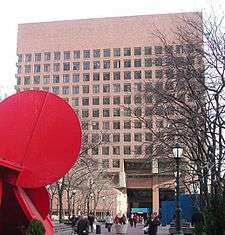Plop art
Plop art (or Plonk art) is a pejorative slang term for public art (usually large, abstract, modernist or contemporary sculpture) made for government or corporate plazas, spaces in front of office buildings, skyscraper atriums, parks, and other public venues. The term connotes that the work is unattractive or inappropriate to its surroundings—that is, it has been thoughtlessly "plopped" where it lies. Plop art is a play on the term pop art. The term was coined by architect James Wines in a 1970 essay, Public Art–Private Art, published in Art in America.[1] The term has been taken up by others, including British sculptor Rachel Whiteread.[2]

"Right now architecture and sculpture are calling to each other, and calling for response that's intelligent, not for more ghastly lumps of sculpture ... which have no sense of scale and are just plonked down in public places." — Anthony Caro (1924–2013), English sculptor.[3]
Some defenders of public art funding have tried to reclaim the term. The book Plop: Recent Projects of the Public Art Fund, celebrates the success of the Public Art Fund in financing many publicly placed works of art over the last few decades, many of which are now beloved, though they may at first have been derided as "ploppings".[4]
References
- "James Wines: The Architect Who Turned Buildings into Art". 2015-07-08.
- "Rachel Whiteread: Turner prize winner criticises 'plop art'". The Guardian. 2017-09-11.
- From an interview with Tim Marlowe for Tate: The Art Magazine, 1994.
- Plop: Recent projects of the Public Art Fund. Merrell Publishers in association with Public Art Fund, New York. 2004. ISBN 9781858942483, 9781858942476.